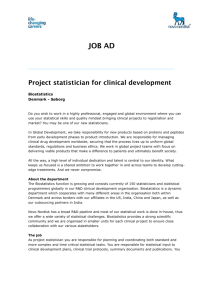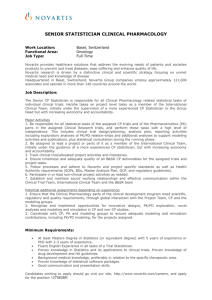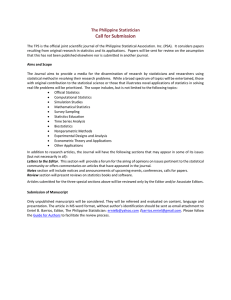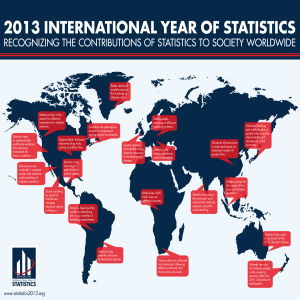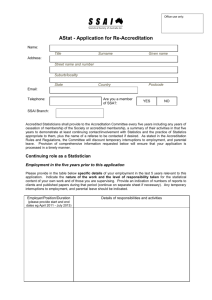Biostatistics in Biomedical and Clinical Research
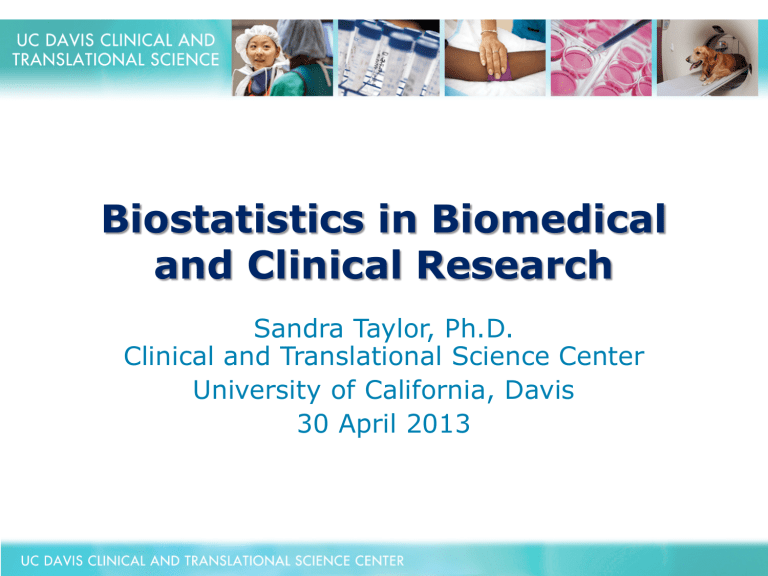
Biostatistics in Biomedical and Clinical Research
Sandra Taylor, Ph.D.
Clinical and Translational Science Center
University of California, Davis
30 April 2013
Do I really need a statistician?
“My study is really simple.”
“I don’t have funding to support a statistician.”
“I don’t know any statisticians.”
“A statistician will make my study more complicated or turn it into a statistics research project.”
Goals and objectives
Understand the role of statisticians in biomedical research and clinical trials
–
What we can do for you
–
When we should be involved
–
Why it’s important
Provide pointers for working with statisticians
Understand what resources are available and how to access those resources
Where are statisticians involved in research projects/clinical trials?
Where are statisticians involved in research projects/clinical trials?
Why and when to work with a statistician?
Planning the study
–
Study design, randomization, sample size
–
Proposal preparation
Conducting the study
–
Interim analyses, DSMB
Evaluating the results
–
Conducting statistical analyses
Reporting the results
–
Interpreting the results
–
Manuscript preparation
The Research Process
“Gee, I wonder if…”
Planning Stage Involvement
Planning Stage Involvement
Statistics can’t fix a poorly designed study!
Planning Stage Activities
Not just sample size calculations
•
Develop specific aims
•
Identify endpoints and formulate testable hypotheses
•
Identify confounding factors, biases
•
Develop study design, randomization scheme, matching protocol
•
Conduct sample size calculations and prepare statistical analysis plan
Formulating specific aims
Identify parameters of interest
Specify testable hypotheses
–
Determines statistical methods
Specific aims determine
–
Study design
–
Sample size calculations
Identify fatal flaws
Specific Aim 1: Determine if new treatment is better than standard care.
What constitutes better?
What measureable parameter reflects
better?
–
Survival, number of events, mean value?
What testable hypothesis addresses the specific aim?
–
H
0
: Mean cholesterol under new treatment does not differ from standard care
–
H a
: Mean cholesterol under new treatment differs from standard care
Study type and design considerations
Prospective Study
–
Randomization
–
Stratification
–
Matching
–
Interim analyses, adaptive or sequential designs
Retrospective Study
–
Confounding variables
–
Site effects and biases in data often overlooked
How many subjects do I need?
Too few – insufficient power to detect differences
Too many – unnecessary costs
Statisticians need input from researchers to determine sample size requirements.
Sample size determination comes at the end of a series of steps.
Specific Aim
Testable
Hypothesis
Study
Design
Statistical
Methods
Sample Size
Calculations
How is sample size determined?
Depends on:
Specific aim – primary hypothesis of the study
Study design
–
These two influence the statistical test.
Effect size to be detected
Variability of the response variable
–
Researchers need to provide this information
Example: New medication study
•
Test: H o
: µ new
= µ old
vs. H a
: µ new
≠ µ
•
Design: Randomized into each arm old
•
Statistical method: t-test
•
σ 2 = variance; Δ = effect size to detect
Researchers need to provide this information .
–
Published results
–
Pilot data
–
Clinically meaningful change
Sample size calculations may not be straight-forward
More complex designs require more complex calculations
Examples:
–
Longitudinal studies
–
Cross-over studies
–
Correlation of outcomes
Sometimes simulations are required
Sample size calculations may not be straight-forward
More complex designs require more complex calculations
Examples:
–
Longitudinal studies
–
Cross-over studies
–
Correlation of outcomes
Sometimes simulations are required
THERE IS NO MAGIC
NUMBER.
Proposal Content
Proposal sections involving statistics
Sample size justification
Statistical analysis plan
–
Statistical methods for each aim
For clinical trials,
Interim analyses/Early stopping rules
Engage a statistician to write or at least review these sections.
Common statistical problems in proposals
Sample size justification absent or insufficiently justified
Lack of statistical analysis plan for all aims, including secondary aims
Inappropriate statistical analysis methods
Common statistical problems in proposals
Sample size justification absent or insufficiently justified
Lack of statistical analysis plan for all aims, including secondary aims
Inappropriate statistical analysis methods
These issues can doom a proposal.
Data Collection and Compilation
Data Collection and Compilation
Valid results require
–
Collection of accurate data
–
Clear and accurate data compilation
Create workable and documented data sets
QA/QC procedures
–
Validation during data entry
–
Periodically audit the data
–
Conduct internal validation of final data
Bad Scene!
RedCAP is user-friendly alternative.
Leverage informatics and biostatistics expertise
Medical informatics group can
–
Create forms for data collection
–
Extract information from EMR
Use inter-disciplinary team to determine what information to collect and how
–
Investigator, practitioners, biostatistician, informatics specialist
–
Ensures information is collected and compiled in a manner that facilitates analysis
Data Do’s and Don’ts
•
Use RedCAP where possible
•
Assign unique ID to each subject and use consistently
•
Remove all PHI prior submitting to statistician
•
Unambiguously and consistently specify missing values
–
Avoid using “0” or blanks for missing values
•
Avoid free text fields
Go forth and collect data!
Statistician activities during the study
•
Sometimes limited involvement by statistician
•
Involvement can include
–
Conducting interim analyses
–
Serving on DSMB
•
Some study designs entail periodic reassessments and statistician will necessarily be involved during the study
–
Two-stage, adaptive or sequential trials
Analysis and
Reporting
Analyzing the data
Conduct statistical analyses
–
Data validation
–
Run statistical tests
Interpret the results
Prepare tables and figures to illustrate findings
Working with a Statistician to
Analyze your Data
Range of support provided
One-time
Advice Only
Select methods
Conduct all analyses
If statistician analyzes the data…
Remove PHI
Provide “clean”, documented data set
Allow sufficient time for analysis
–
Rule of Thumb is 4 to 6 weeks
Provide references from similar studies if available
Iterative and interactive process
Report/Publication Preparation
Craft statistical analysis section
Contribute to results section
Generate tables and figures
Biostatistics Resources at UC Davis
Clinical and Translational Science
Center
–
Biostatistics Workshop: 12-1 on Tuesdays sltaylor@ucdavis.edu
–
Biostatistics Core
•
Assist with study design, grant writing, data analysis and interpretation
•
Application for Resource Use (AFRU) http://www.ucdmc.ucdavis.edu/ctsc/
Division of Biostatistics
Other CTSC Resources
Biomedical Informatics
Clinical Research Center
Clinical Trials Resource Group
Community Engagement
Clinical Research Ethics
Translational Technologies
Pilot Studies Funding www.ucdmc.ucdavis.edu/ctsc/
